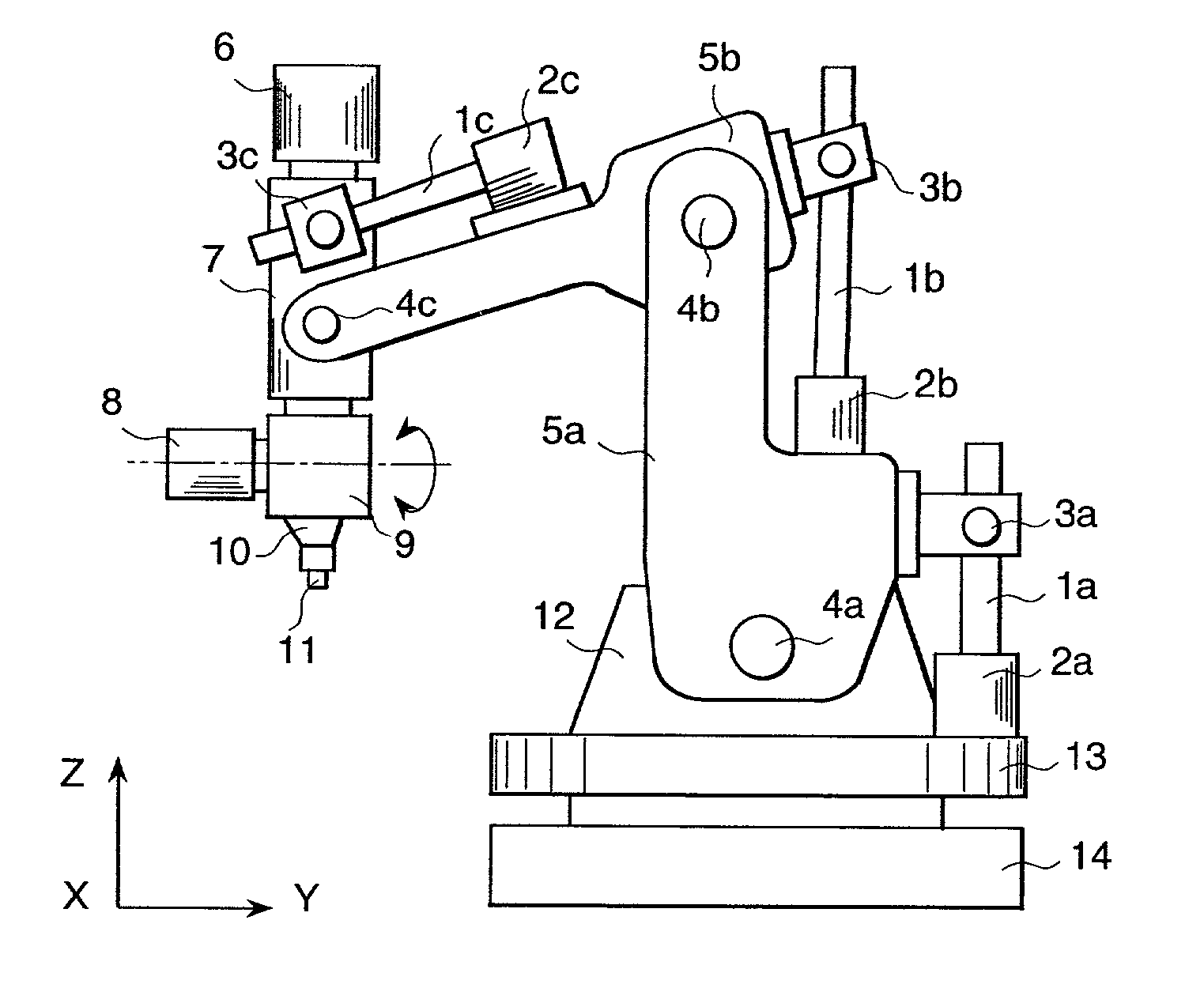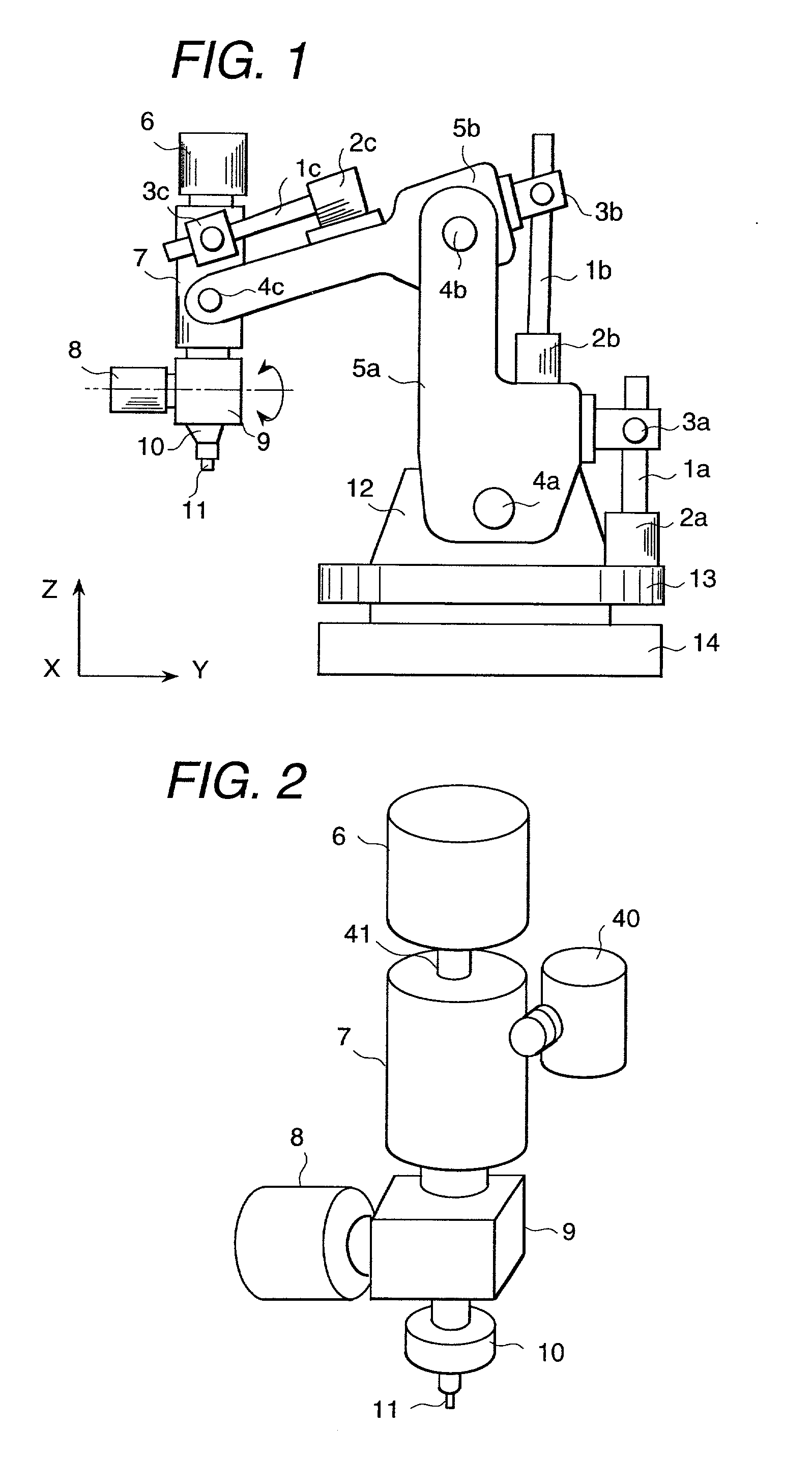Friction stir welding method and apparatus, and welded structure
a friction stir welding and friction stir technology, applied in the direction of soldering apparatus, manufacturing tools, auxillary welding devices, etc., can solve the problems of inability to join arbitrary curved surfaces having a three-dimensional shape, inability to determine a specific direction, and inability to join arbitrary curved surfaces of a three-dimensional shap
- Summary
- Abstract
- Description
- Claims
- Application Information
AI Technical Summary
Problems solved by technology
Method used
Image
Examples
first embodiment
[0067] (First Embodiment)
[0068] FIG. 1 is an entire block diagram showing an example of a friction stir welding apparatus according to the present invention. The numerals 1a, 1b and 1c denote ball screws, numerals 2a, 2b and 2c denote servo motors, numerals 3a, 3b and 3c denote bearings, numerals 4a, 4b and 4c denote link pins, numerals 5a and 5b denote second and first arms, respectively, numeral 6 denotes a main spindle rotating motor, numeral 7 denotes a pivoting member, numeral 8 denotes a bending drive member, numeral 9 denotes a rotational axis bending member, numeral 10 denotes a chucking member, numerals 11, 11a and 11b denote rotating tools, numeral 12 denotes a support base, numeral 13 denotes a rotary table, and numeral 14 denotes an apparatus base.
[0069] The second and first arms 5a, 5b are pivotable about the link pins 4a and 4b, respectively, as fulcrums. The main spindle rotating motor 6 and the rotating tool 11 are mounted to a distal end of the first arm 5b and can ...
second embodiment
[0077] (Second Embodiment)
[0078] FIG. 10 is an entire configuration diagram showing another example of a friction stir welding apparatus according to the present invention, in which the numeral 28 denotes a column, numeral 27 denotes an apparatus base, and numeral 26 denotes a workpiece mount.
[0079] In the same figure, the directions (X, Y, Z) indicated with both-end arrows are moving axis directions, which are orthogonal to one another. A main spindle rotating motor 6, pivoting member 7, bending drive member 8, rotational axis bending member 9, chucking member 10, and rotating tool 11 are mounted to a member adapted to move in Z-axis direction. All of these components move with motion of the Z axis.
[0080] With a driving force from a servo motor, the pivoting member 7 pivots about an axis parallel to the Z axis though not shown. The total pivoting angle is 370.degree. as is the case with the previous embodiment.
[0081] With the bending drive member 8, the direction of the rotational ...
third embodiment
[0088] (Third Embodiment)
[0089] FIG. 12 is a conceptual diagram showing a system configuration of a friction stir welding apparatus according to the present invention, in which the numeral 29 denotes a sensor, numeral 30 denotes the friction stir welding apparatus, numeral 31 denotes a workpiece, numeral 32 denotes an arithmetic unit, and numeral 33 denotes a control unit.
[0090] A coordinate value calculated from the shape of workpiece before the start of welding, a normal line direction of a joint region, and a tangential direction of a joint line are inputted as initial values to the control unit 33.
[0091] The friction stir welding apparatus 30 starts welding on the basis of the initial values. At the same time, the sensor 29 detects a positional relation between a rotating tool 11 and the workpieces 31 and inputs the result of the detection to the arithmetic unit 32. The arithmetic unit 32 collates the detection result with the initial values and inputs amendment values based on ...
PUM
| Property | Measurement | Unit |
|---|---|---|
| angle | aaaaa | aaaaa |
| attack angle | aaaaa | aaaaa |
| rotational angle | aaaaa | aaaaa |
Abstract
Description
Claims
Application Information
 Login to View More
Login to View More - R&D
- Intellectual Property
- Life Sciences
- Materials
- Tech Scout
- Unparalleled Data Quality
- Higher Quality Content
- 60% Fewer Hallucinations
Browse by: Latest US Patents, China's latest patents, Technical Efficacy Thesaurus, Application Domain, Technology Topic, Popular Technical Reports.
© 2025 PatSnap. All rights reserved.Legal|Privacy policy|Modern Slavery Act Transparency Statement|Sitemap|About US| Contact US: help@patsnap.com



